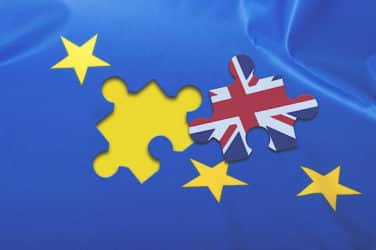On 23 June 2016 the UK decided to withdraw from the European Union (EU) as British people voted to leave with 52% share of the vote. As a result, Brexit stories have dominated news headlines for the past year. Brexit negotiations will start at about 11:00 BST at European Commission buildings in Brussels today.
CLS examines whether Brexit-related events since the referendum have had an impact on the foreign exchange market, using data published by CLS on Quandl .
- Daily foreign exchange activity
We first review daily traded GBPUSD volumes since the referendum and Brexit-related events have had a significant impact on the FX market, leading to periods of heightened trading activity. It is interesting to note that, while both the referendum on EU membership and the UK general election had unexpected results, the referendum had a bigger impact on the FX market and produced a much higher spike in volumes. The triggering of Article 50, on the other hand, was expected and as a result, the market reaction was subdued.
- Hourly foreign exchange activity
Having reviewed daily traded activity, we then examine hourly volumes and the eight days in the period from 23 June 2016 to 12 June 2017 that produced the highest absolute hourly deviations for GBPUSD volumes from the corresponding 2016 average hourly volumes. All of these days coincided with Brexit-related events.
- 24 June 2016: Referendum results – UK votes to leave the EU.
The last polling before the referendum showed a statistical tie. However, both financial and betting markets priced in a Remain victory and GBPUSD rose in the last days preceding the referendum. The YouGov “pseudo-exit” poll indicated that Remain was favoured by 52% vs. Leave at 48%. As a result, GBPUSD continued to rise to a high of 1.5018 at 22:00. With results from different areas being published in the early hours of 24 June 2016, betting odds moved in favour of a Leave result and ITV forecasted a 75% chance of a Leave win. This was an unexpected result for the market and volumes peaked at 03:00. GBPUSD plummeted to a daily low of 1.3229, reached in the hour starting at 05:00.
- 30 June 2016: Carney hints Bank of England may need to reduce rates.

Mark Carney, Financial Stability Board
GBPUSD volumes peaked and the GBPUSD FX rate dropped after Bank of England Governor, Mark Carney, said the central bank may need to loosen monetary policy as it tries to contain the negative effects from Britain’s decision to quit the European Union. He indicated that this may come within the following few months.
- 14 July 2016: Bank of England keeps rates on hold.
Against market expectations of an interest rate cut, the Bank of England voted 8 to 1 to leave the bank rate on hold at 0.50%. As a result, GBPUSD spiked to a two-week high of 1.3475.
- 04 August 2016: Bank of England reduces rates.
The Bank of England unveiled an “exceptional” package of stimulus including the Bank of England’s first interest-rate cut in seven years, as policy makers slashed growth forecasts, as a result of the referendum vote. The central bank cut the base rate from 0.5% to 0.25% and complemented quantitative easing (QE) with corporate bond purchases and a scheme to encourage banks to pass through the lower interest rates.
- 07 October 2016: Sterling’s flash crash.
In the span of several minutes in early Asia trading, GBPUSD plunged from 1.2614 to 1.0932 (as recorded in the CLS system) before retracing much of the move. According to a BIS report1, the beginning of this extreme decline in sterling was caused by significant demand to sell sterling to hedge option positions and, to a lesser extent, stop-loss orders. The presence, outside the currency’s core time zone, of staff less experienced in trading sterling, with lower risk limits and risk appetite, and with less expertise in the suitability of particular algorithms for the prevailing market conditions, appears to have further amplified the movement. It is hard to qualify the flash crash as a Brexit-related event but it happened amid negative sentiment towards the pound, days after British Prime Minister Theresa May outlined for the first time her vision for Brexit at the Conservative Party conference.
- 03 November 2016: UK High Court decision and Bank of England interest rate decision.
GBPUSD volumes peaked after the UK High Court’s ruling that the Prime Minister does not have the right to unilaterally trigger Article 50, and that the decision requires Parliament’s approval. Later on the Bank of England left interest rates unchanged and the governor’s message was that the next move could be to tighten or loosen monetary policy. The change came as the pound’s fall fanned inflation, and the economy performed better than anticipated in August.
- 17 January 2017: UK Prime Minister Brexit speech.
GBPUSD FX rate rose and GBPUSD volumes peaked as Prime Minister Theresa May set out a 12-point Brexit plan.2 She announced that the UK will seek a customs agreement with the EU and that its membership in the single market will be revoked. She also noted that the Parliament would vote on the negotiated deal before leaving the EU.
- 18 April 2017: British Prime Minister calls snap election.
GBPUSD volumes peaked and GBPUSD FX rate rose over 2% to a six month high after Prime Minister Theresa May announced a snap election on 08 June. Early polling showed that May’s Conservatives enjoyed a material lead against the Labour Party, and a victory could deliver May a larger majority and solidify the legitimacy of her mandate, given her status as an unelected leader.
Conclusion
It seems that initial reaction to the referendum results was the strongest and produced the highest daily peak in GBPUSD volumes. Nevertheless, Brexit-related events continued to occur during the whole period and to produce spikes in GBPUSD volumes.
This report is based on data available at the time of writing. As a result, only data until 12 June 2017 is included and subsequent events and data are not considered.
- Notes on the data
The data in this report is based on trades submitted to the CLS settlement and aggregation services. The data is adjusted to equate to the same reporting convention used by the Bank for International Settlements (BIS) and the semi-annual foreign exchange committee market reports. These surveys only report one side of any trade, and only the far leg of FX swap trades, to avoid double counting the total amount of trades.
In determining the time of submission, only matched trades are included and we use the earlier of the two submission times as the trade time proxy. We receive confirmation on the majority of trades from settlement members within 2 minutes of trade execution.
We determine the instrument type using an algorithm. The data here is restricted to 32 currency pairs which meet the volume requirements of the algorithm with the exception of HUF/USD which was included to provide visibility into the HUF which was added in November 2015.
Please contact data@cls-services.com with any questions you have relating to the data used in the report.
Source: CLS Analytics





